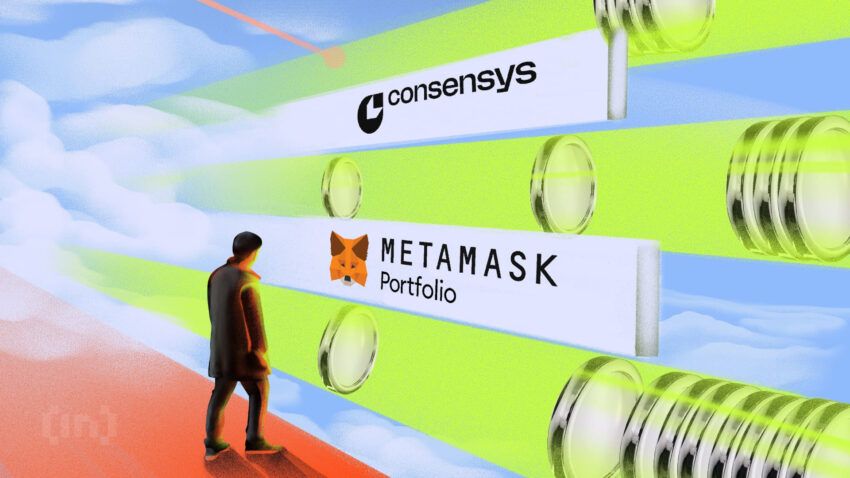Staking can be a complicated process, but with the addition of validator staking to MetaMask Portfolio, the platform is taking the lead in making it easier.
Bypassing the complex software and hardware requirements typically linked with validator nodes, this new approach enables users to engage in the consensus and security mechanisms of the Ethereum network.
By delving into an insightful discussion with Matthieu Saint Olive, Product Manager for Consensys Staking, and Abad Mian, Product Manager at MetaMask, we are given a glimpse into the future of staking.
Join us as we explore this unique collaboration between MetaMask and Consensys Staking!
1. Could you start by introducing yourself, detailing your role at MetaMask, and describing your involvement with the validator staking feature?
Abad: I’m Abad Mian, Product Manager for the MetaMask team that built Validator Staking together with Matthieu Saint Olive, Product Manager for Consensys Staking.
We’re excited to talk about MetaMask and Consensys Staking. Please remember the information presented is for informational purposes only and should not be construed as legal or investment advice.
Most of what we’re talking about is the security, decentralization, and efficiency of staking and opportunities to participate in staking through Consensys and Metamask. Any decisions based on this information are at your own risk, and it is recommended to seek professional advice for legal or investment matters.
2. Can you explain the concept of validator staking in MetaMask Portfolio and how it simplifies the staking process for users?
Abad: Validator Staking allows MetaMask customers to stake and receive rewards on their ETH by running their own validator nodes without worrying about complex technical requirements. Managing a node’s hardware and software while maintaining strong performance can be difficult, but Validator Staking solves this problem.
3. Can you tell us a bit more about the introduction of validator staking led by two of the Consensys product teams: MetaMask and Consensys staking?
Abad: The Consensys Staking team, led by Matthieu Saint-Olive, has one of the best track records in the industry of running highly-performant validator nodes. They’ve been in this game as long as anyone else, since the inception of the Beacon chain, and have never been slashed.
They help some of the largest participants in the staking ecosystem run their own validator nodes. We’re excited to extend these capabilities to MetaMask users.
Matthieu: Staking is a necessary piece of Ethereum. It is essentially compensation for providing decentralized security and data validation.
This mechanism enables the network to reach a consensus on which blocks to produce in a decentralized manner (read, Staking is data validation, not investment) and, therefore, underpins the entire wave of permissionless web3 innovation.
Through staking, Ethereum offers economic incentives to network participants to contribute to the network consensus and security, leading to self-sustaining positive-sum network effects.
At Consensys, we believe it is important we contribute to 1) making Ethereum more secure by helping more people to stake and 2) making Ethereum more decentralized by offering an alternative to centralized staking solutions. This is what led us to launch Validator Staking in MetaMask.
4. Security is paramount in cryptocurrency staking. Can you discuss the security measures and certifications that Consensys Staking brings to the table for MetaMask users?
Matthieu: Consensys Staking has a track record of operating Ethereum validators since the launch of the Beacon Chain in December 2020, with tier 1 performance, more than 1 million ETH staked to date, and no slashing event ever.
Our infrastructure and processes are designed to optimize the rewards earned by our users while minimizing the risks. In terms of security measures, there are 4 components I’d like to mention:
- Certifications: Consensys is ISO 27001:2022 certified, a security assurance covering the security of our people, technology, and processes. In addition, Consensys Staking is also SOC2 Type 2 which examines our internal controls and systems related to security, availability, processing integrity, confidentiality, and privacy of data.
- Slashing prevention: We protect our users against slashing through multiple tools and processes, including never deploying the same validator key to multiple locations or multiple validators and using web3 signer slashing protection (read more on slashing here). Beyond slashing, we also have 24/7 monitoring, alerting, and Site Reliability Engineers to ensure our validators always perform as well as expected.
- No single point of failure: our staking infrastructure is distributed across 2 clouds (Azure, AWS), 6 different regions (2 in the US, 2 in Europe, 2 in Asia), 2 consensus clients (Teku, Lighthouse) and 2 execution clients (Besu, Geth).
- Smart contract security: in order to power MetaMask Validator Staking product, we are leveraging a smart contract that went through thorough audits from multiple tier 1 auditors, including Consensys Diligence, and a bug bounty program. We also have tools and processes in place to monitor and alert on any suspicious activity on the smart contract.
5. MetaMask’s validator staking feature emphasizes convenience without compromising self-custody. How does this balance benefit users, and why is it important for staking platforms to offer such autonomy?
Abad: Striking the right balance between convenience and self-custody can be difficult, but we believe it’s important to ensure that the staking solution you choose allows you to maintain control over key functions of your validator.
Matthieu: Self-custody is a core principle of MetaMask and Consensys. It has many benefits but also raises new challenges. Finding the right level of convenience without compromising self-custody is critical to making web3 successful.
6. Ethereum’s shift to a proof-of-stake model through ‘The Merge’ has quite some big ripple effects on the ecosystem. How exactly does MetaMask’s validator staking slot into this evolved landscape, and what implications does it have for network security?
Abad: We believe that Ethereum’s decentralized nature is critical to its security and features like Validator Staking can help ensure that the Ethereum network’s Beacon chain is not dominated by any single entity.
Matthieu: The Merge was an incredible milestone in the Ethereum journey, which has – among other things – reduced the carbon footprint of the network by 99.95% overnight (read more about the Merge here).
Early on, Consensys contributed to this transition by developing an open-source consensus layer client (Teku) and a self-custodial staking platform (Consensys Staking) in addition to the existing execution layer client (Besu).
By making staking conveniently accessible to MetaMask users directly from their wallets, we are reaching a new milestone in helping network participants secure the Ethereum network and be rewarded for it.
7. Ethereum staking can be quite technical and inaccessible to some. How does MetaMask’s solution address these barriers, and what does this democratization mean for the future of staking?
Abad: Validator Staking means you’ll never have to worry about complex hardware or software requirements that are a barrier to entry for many individuals who’d like to run their own node.
Second, we’ve built an easy-to-understand UI that makes it easy to stake, track and withdraw your rewards in just a few clicks, without complex onboarding requirements. Together, these make it possible for anyone with enough ETH to quickly and easily run their own validator node.
8. Yields and rewards are a major attraction for stakers. Can you discuss how MetaMask and Consensys Staking optimize rewards for users, and how does this compare to the network average?
Matthieu: Ethereum validators earn rewards for proposing new blocks and attesting the validity of blocks proposed by other validators. As such, validators’ rewards are optimized when we minimize the number of missed attestations and missed blocks. Those are 2 important metrics we closely monitor and continuously optimize for.
Also, we are using our own fork of MEV boost to ensure the blocks proposed by our validators generate the highest MEV rewards for our users. In Q4 2023, on average, our validators’ reward rate was 10% higher than ETH.store, the network average reward rate.
While staking rewards are surely a key motivation for users to stake, it is important not to forget staking is the mechanism that enables Ethereum data validation.
While we continuously optimize validators’ rewards, we also strive to contribute to network security through diversity. We use multiple consensus and execution clients across multiple cloud providers in multiple regions.
9. How has the community reacted to MetaMask’s validator staking?
Abad: The reception has been amazing! We’ve been very pleased with feedback from the community and the amount of activity we’ve seen so far. And we’re taking feedback seriously as we build our future roadmap.
10. How do you see the role of staking evolving within crypto, and what trends do you predict for the coming years?
Abad: I wish I had a crystal ball! The biggest near-term trends I’d suggest keeping an eye on within the Ethereum staking landscape are (A) re-staking, and (B) validator diversity, in terms of both (1) the consensus and execution layer client software that power validators and (2) the diversity of entities running validator nodes.
Matthieu: Over the last few years, the majority of new layer 1 networks decided to use Proof of stake for their consensus mechanism. To date, there are already dozens of assets that can be staked to secure those L1s. In the coming years, I see two trends worth watching, even if still early days:
- Emergence of Layer 2 networks: those networks are proving great traction because they reduce transaction costs and accelerate transaction speed, while relying on Ethereum Mainnet for security. Therefore we can expect a lot of user activity and funds to move from Ethereum Mainnet to those L2s, which leads to 2 questions we are actively working on: how can users contribute to Ethereum staking when their funds are held on a L2? How can we contribute to L2 security and decentralization?
- Emergence of restaking: Eigenlayer restaking has caught sizable attention in the Ethereum community over the last months. Ultimately, the belief is decentralized network architectures can be more granular than they are now and can rely on highly specialized components to facilitate execution, consensus, data availability, sequencing, oracles and more. In modular architectures, each functionality can be done separately by different parties and networks, and each of them needs to be secure. The security of those components can be facilitated through ETH restaking.
11. For users new to staking or cryptocurrency in general, what advice would you give them when considering staking through MetaMask Portfolio?
Abad: Do you want to contribute to decentralization and network security while receiving rewards on your staked ETH without any of the technical complexities? If so, strongly consider Validator Staking.
We love highly technical solo stakers that manage validator hardware and software on their own, but we know that this isn’t easy for everyone, especially if you want to optimize the performance of your validator. MetaMask Validator Staking solves this problem.
12. Finally, beyond validator staking, what other innovations or services can MetaMask users look forward to in the near future?
Abad: Our immediate roadmap includes improvements to Validator Staking, such as batched withdrawals that make it easy to withdraw from multiple validators in fewer transactions. Beyond that we’re exploring opportunities to further democratize access to ETH staking for the vast majority of ETH holders who own less than 32 ETH.
Conclusion: making blockchain accessible through validator staking by MetaMask
As our conversation with Abad Mian and Matthieu Saint Olive comes to a close, it becomes clear that validator staking by MetaMask is an important step in the process of making blockchain technology accessible to a wider audience.
In addition to streamlining staking, this feature represents a giant leap forward in the direction of an inclusive, secure, and decentralized future.
A fine example of innovation, validator staking by MetaMask with the help of Consensys Staking removes the complexity of blockchain technology as an obstacle to participation.
It welcomes a new age in the development of decentralized finance by inviting users from all backgrounds to participate in network security and reap the benefits.
Disclaimer
In compliance with the Trust Project guidelines, this guest expert article presents the author’s perspective and may not necessarily reflect the views of BeInCrypto. BeInCrypto remains committed to transparent reporting and upholding the highest standards of journalism. Readers are advised to verify information independently and consult with a professional before making decisions based on this content. Please note that our Terms and Conditions, Privacy Policy, and Disclaimers have been updated.


